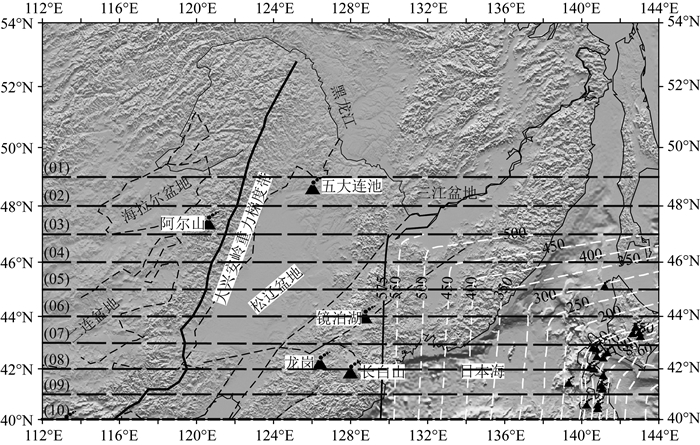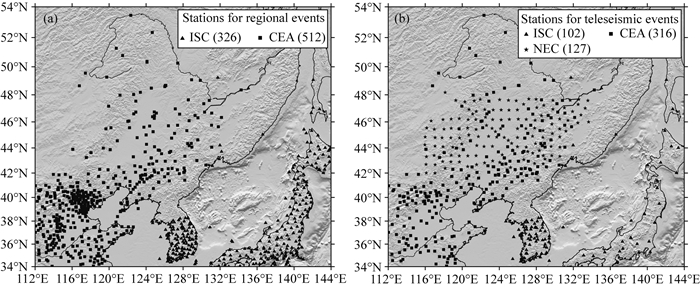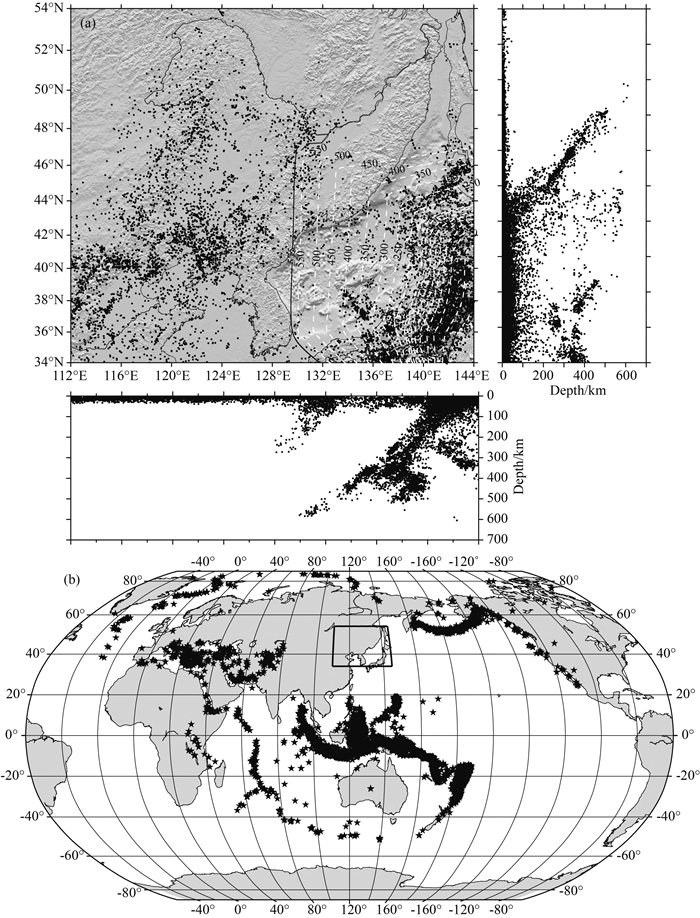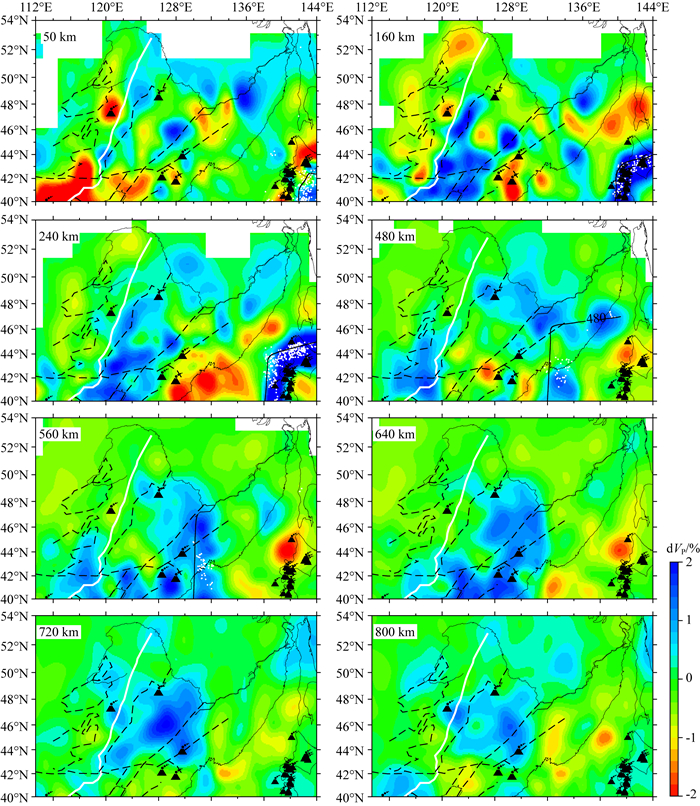Ai Y S, Zheng T Y, Xu W W, et al. 2003. A complex 660 km discontinuity beneath northeast China. Earth and Planetary Science Letters, 212(1-2): 63-71. DOI:10.1016/S0012-821X(03)00266-8 |
|
Crotwell H P, Owens T J, Ritsema J. 1999. The TauP Toolkit:Flexible seismic travel-time and ray-path utilities. Seismological Research Letters, 70(2): 154-160. DOI:10.1785/gssrl.70.2.154 |
|
|
Fong D C L, Saunders M. 2011. LSMR:An iterative algorithm for sparse least-squares problems. SIAM Journal on Scientific Computing, 33(5): 2950-2971. DOI:10.1137/10079687X |
Fukao Y, Obayashi M. 2013. Subducted slabs stagnant above, penetrating through, and trapped below the 660 km discontinuity. Journal of Geophysical Research:Solid Earth, 118(11): 5920-5938. DOI:10.1002/2013JB010466 |
|
|
Huang J L, Zhao D P. 2006. High-resolution mantle tomography of China and surrounding regions. Journal of Geophysical Research:Solid Earth, 111(B9): B09305. DOI:10.1029/2005JB004066 |
Kennett B L N, Engdahl E R. 1991. Traveltimes for global earthquake location and phase identification. Geophysical Journal International, 105(2): 429-465. DOI:10.1111/gji.1991.105.issue-2 |
Koppers A A P, Morgan J P, Morgan J W, et al. 2001. Testing the fixed hotspot hypothesis using 40Ar/ 39Ar age progressions along seamount trails. Earth and Planetary Science Letters, 185(3-4): 237-252. DOI:10.1016/S0012-821X(00)00387-3 |
Lei J S, Zhao D P. 2005. P-wave tomography and origin of the Changbai intraplate volcano in Northeast Asia. Tectonophysics, 397(3-4): 281-295. DOI:10.1016/j.tecto.2004.12.009 |
Li C, Van Der Hilst R D. 2010. Structure of the upper mantle and transition zone beneath Southeast Asia from traveltime tomography. Journal of Geophysical Research:Solid Earth, 115(B7): B07308. DOI:10.1029/2009JB006882 |
|
Li J, Chen Q F, Vanacore E, et al. 2008. Topography of the 660-km discontinuity beneath northeast China:Implications for a retrograde motion of the subducting Pacific slab. Geophysical Research Letters, 35(1): L01302. DOI:10.1029/2007GL031658 |
Li J, Wang X, Wang X J, et al. 2013. P and SH velocity structure in the upper mantle beneath Northeast China:Evidence for a stagnant slab in hydrous mantle transition zone. Earth and Planetary Science Letters, 367: 71-81. DOI:10.1016/j.epsl.2013.02.026 |
|
|
Li X Q, Yuan X H. 2003. Receiver functions in northeast China-Implications for slab penetration into the lower mantle in Northwest Pacific subduction zone. Earth and Planetary Science Letters, 216(4): 679-691. DOI:10.1016/S0012-821X(03)00555-7 |
Liu L J, Zhou Q. 2015. Deep recycling of oceanic asthenosphere material during subduction. Geophysical Research Letters, 42(7): 2204-2211. DOI:10.1002/2015GL063633 |
Liu X, Zhao D P, Li S Z, et al. 2017. Age of the subducting Pacific slab beneath East Asia and its geodynamic implications. Earth and Planetary Science Letters, 464: 166-174. DOI:10.1016/j.epsl.2017.02.024 |
Maruyama S, Isozaki Y, Kimura G, et al. 1997. Paleogeographic maps of the Japanese Islands:Plate tectonic synthesis from 750 Ma to the present. Island Arc, 6(1): 121-142. DOI:10.1111/iar.1997.6.issue-1 |
Paige C C, Saunders M A. 1982. LSQR:An algorithm for sparse linear equations and sparse least squares. ACM Transactions on Mathematical Software, 8(1): 43-71. DOI:10.1145/355984.355989 |
Safonova I Y, Santosh M. 2014. Accretionary complexes in the Asia-Pacific region:Tracing archives of ocean plate stratigraphy and tracking mantle plumes. Gondwana Research, 25(1): 126-158. DOI:10.1016/j.gr.2012.10.008 |
|
|
Sharp W D, Clague D A. 2006. 50-Ma initiation of Hawaiian-Emperor bend records major change in Pacific plate motion. Science, 313(5791): 1281-1284. DOI:10.1126/science.1128489 |
|
Takeuchi N, Kawakatsu H, Tanaka S, et al. 2014. Upper mantle tomography in the northwestern Pacific region using triplicated P waves. Journal of Geophysical Research:Solid Earth, 119(10): 7667-7685. DOI:10.1002/2014JB011161 |
|
Tian Y, Liu C, Feng X. 2011. P-wave velocity structure of crust and upper mantle in Northeast China and its control on the formation of mineral and energy. Chinese Journal of Geophysics (in Chinese), 54(2): 407-414. DOI:10.3969/j.issn.0001-5733.2011.02.017 |
Tian Y, Zhu H X, Zhao D P, et al. 2016. Mantle transition zone structure beneath the Changbai volcano:Insight into deep slab dehydration and hot upwelling near the 410 km discontinuity. Journal of Geophysical Research:Solid Earth, 121(8): 5794-5808. DOI:10.1002/2016JB012959 |
|
Wei W, Xu J D, Zhao D P, et al. 2012. East Asia mantle tomography:New insight into plate subduction and intraplate volcanism. Journal of Asian Earth Sciences, 60: 88-103. DOI:10.1016/j.jseaes.2012.08.001 |
Wei W, Zhao D P, Xu J D, et al. 2015. P and S wave tomography and anisotropy in Northwest Pacific and East Asia:Constraints on stagnant slab and intraplate volcanism. Journal of Geophysical Research:Solid Earth, 12(3): 1642-1666. DOI:10.1002/2014JB011254 |
Wessel P, Smith W H F. 1998. New, improved version of Generic Mapping Tools released. EOS, 79(47): 579. DOI:10.1029/98EO00426 |
Wilde S A. 2015. Final amalgamation of the Central Asian Orogenic Belt in NE China:Paleo-Asian Ocean closure versus Paleo-Pacific plate subduction-A review of the evidence. Tectonophysics, 662: 345-362. DOI:10.1016/j.tecto.2015.05.006 |
Xu W L, Ji W Q, Pei F P, et al. 2009b. Triassic volcanism in eastern Heilongjiang and Jilin provinces, NE China:Chronology, geochemistry, and tectonic implications. Journal of Asian Earth Sciences, 34(3): 392-402. DOI:10.1016/j.jseaes.2008.07.001 |
Xu W L, Xu Y G. 2007. Diachronous lithospheric thinning of the North China Craton and formation of the Daxin'anling-Taihangshan gravity lineament. Lithos, 96(1-2): 281-298. DOI:10.1016/j.lithos.2006.09.013 |
|
|
|
Ye L L, Li J, Tseng T L, et al. 2011. A stagnant slab in a water-bearing mantle transition zone beneath northeast China:Implications from regional SH waveform modelling. Geophysical Journal International, 186(2): 706-710. DOI:10.1111/j.1365-246X.2011.05063.x |
|
Zhang R Q, Gao Z Y, Wu Q J, et al. 2016. Seismic images of the mantle transition zone beneath Northeast China and the Sino-Korean craton from P-wave receiver functions. Tectonophysics, 675: 159-167. DOI:10.1016/j.tecto.2016.03.002 |
Zhao D P, Hasegawa A, Horiuchi S. 1992. Tomographic imaging of P and S wave velocity structure beneath northeastern Japan. Journal of Geophysical Research:Solid Earth, 97(B13): 19909-19928. DOI:10.1029/92JB00603 |
Zhao D P, Hasegawa A, Kanamori H. 1994. Deep structure of Japan subduction zone as derived from local, regional, and teleseismic events. Journal of Geophysical Research:Solid Earth, 99(B11): 22313-22329. DOI:10.1029/94JB01149 |
Zhao D P. 2004. Global tomographic images of mantle plumes and subducting slabs:Insight into deep Earth dynamics. Physics of the Earth and Planetary Interiors, 146(1-2): 3-34. DOI:10.1016/j.pepi.2003.07.032 |
Zhao D P, Tian Y, Lei J S, et al. 2009. Seismic image and origin of the Changbai intraplate volcano in East Asia:Role of big mantle wedge above the stagnant Pacific slab. Physics of the Earth and Planetary Interiors, 173(3-4): 197-206. DOI:10.1016/j.pepi.2008.11.009 |
Zhao D P, Tian Y. 2013. Changbai intraplate volcanism and deep earthquakes in East Asia:A possible link?. Geophysical Journal International, 195(2): 706-724. DOI:10.1093/gji/ggt289 |
Zheng X F, Ouyang B, Zhang D N, et al. 2009. Technical system construction of Data Backup Centre for China Seismograph Network and the data support to researches on the Wenchuan earthquake. Chinese Journal of Geophysics (in Chinese), 52(5): 1412-1417. DOI:10.3969/j.issn.0001-5733.2009.05.031 |
Zheng X F, Yao Z X, Liang J H, et al. 2010. The role played and opportunities provided by IGP DMC of China National Seismic Network in Wenchuan earthquake disaster relief and researches. Bulletin of the Seismological Society of America, 100(5B): 2866-2872. DOI:10.1785/0120090257 |
Zhou J B, Wilde S A, Zhang X Z, et al. 2009. The onset of Pacific margin accretion in NE China:Evidence from the Heilongjiang high-pressure metamorphic belt. Tectonophysics, 478(3-4): 230-246. DOI:10.1016/j.tecto.2009.08.009 |
Zhou J B, Cao J L, Wilde S, et al. 2014. Paleo-Pacific subduction-accretion:Evidence from Geochemical and U-Pb zircon dating of the Nadanhada accretionary complex, NE China. Tectonics, 33(12): 2444-2466. DOI:10.1002/2014TC003637 |
|
|
|
|
|
|
|
|
|
|
|
|
|
|
|
 2019, Vol. 62
2019, Vol. 62










